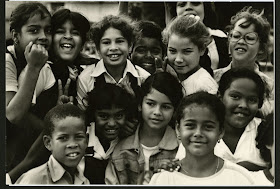 |
Man participating in a school boycott in New York, 1964. Frank Espada Photographs, ca. 1970-2000, Archives Center, National Museum of American History. AC1395-0000004. |
 |
| School children in Puerto Rico. Undated. Frank Espada Photographs, ca. 1970-2000, Archives Center, National Museum of American History. AC1395-0000002. |
Included in the collection are black-and-white photographs taken by Frank Espada during the Civil Rights Era. It’s here that it became clear to me how much his life revolved around community activism. He was driven by a sense of social justice and worked to improve his community and counter the racism and discrimination of the 60s and early 70s. In two photographs, he appears standing next to a sign that reads, “East New York Action”. Espada founded East New York Action, a community organization created for the sole purpose of addressing issues in the community. East New York Action organized rent strikes, educated people on welfare rights, and registered voters. There are photographs of the Puerto Rican Community Development Project, an organization that Espada worked for as a community organizer. Additionally, he had strong ties with the United Bronx Parents and the Young Lords, among others. Frank Espada was a determined leader with an ability to connect with others and a dedication to his community that was hard to match.
I think of Frank Espada and his work, both as a photographer and as a community leader, and comprehend his vision of the world. He saw beauty in every photograph, but understood that the most important thing he could do was help others through their struggles and listen to their stories when the world surrounding them chose to turn a blind eye. It is this part of the collection that impacts me the most. As I continue my walk through D.C., I ask myself, “What would Frank Espada do if he witnessed everything I see on my walks to work?”
I think back to the 30 cassettes in the collection that I spent two weeks digitizing. Each cassette had full-length interviews conducted by Frank Espada of community leaders such as Jack Agüeros, Willy Vasquez, and Juan Gonzalez, among others. Personally, it was my favorite part of the collection, as I was able to place a voice on several of the faces I saw in photographs. It was here that I realized what Espada was doing: he was giving a voice to the community. While his photographs did the work of establishing a national presence of Puerto Rican culture and identity, these interviews showcase the collective work that was being done across the country to improve the lives of Puerto Ricans and other Latinos living in the United States. They were a clear reminder that we must give a voice to the communities that are often silenced by the social barriers of inequality.
So what would Frank Espada do? He would remind us that we must take the time to listen to each other’s stories and to speak up for ourselves and for others. He would remind us that if we do not take the time to do these things, we are incapable of seeing the world through more than one lens, oblivious of the things happening around us. And of course, he would do all of this with a camera in hand, ready to capture us in our most intimate moments. This is what Frank Espada would do.
Edwin Rodriguez, Intern
Archives Center, National Museum of American History
I think of Frank Espada and his work, both as a photographer and as a community leader, and comprehend his vision of the world. He saw beauty in every photograph, but understood that the most important thing he could do was help others through their struggles and listen to their stories when the world surrounding them chose to turn a blind eye. It is this part of the collection that impacts me the most. As I continue my walk through D.C., I ask myself, “What would Frank Espada do if he witnessed everything I see on my walks to work?”
I think back to the 30 cassettes in the collection that I spent two weeks digitizing. Each cassette had full-length interviews conducted by Frank Espada of community leaders such as Jack Agüeros, Willy Vasquez, and Juan Gonzalez, among others. Personally, it was my favorite part of the collection, as I was able to place a voice on several of the faces I saw in photographs. It was here that I realized what Espada was doing: he was giving a voice to the community. While his photographs did the work of establishing a national presence of Puerto Rican culture and identity, these interviews showcase the collective work that was being done across the country to improve the lives of Puerto Ricans and other Latinos living in the United States. They were a clear reminder that we must give a voice to the communities that are often silenced by the social barriers of inequality.
 |
| Self-portrait of Frank Espada standing in front of East New York Action. Undated. AC1395-0000001. |
Edwin Rodriguez, Intern
Archives Center, National Museum of American History

No comments:
Post a Comment